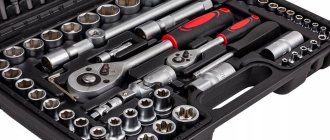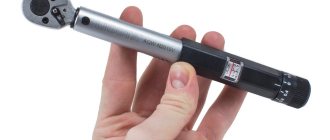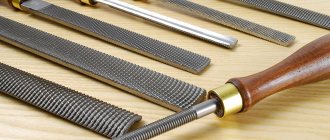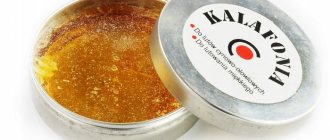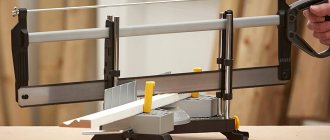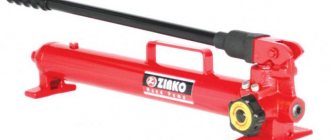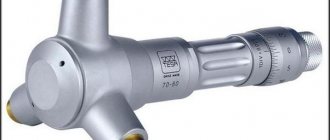The work of assembling and disassembling mechanisms and assemblies involves unscrewing nuts. Some of them are in places where a regular open-end wrench cannot reach. A socket wrench is available for unscrewing such hard-to-reach nuts.
What is a socket wrench?
This is a device for unscrewing that is put on the nut from the end (top). By analogy with the carob, it has a double-sided design. However, a socket wrench is a tool that comes in a variety of modifications. You can find angular, tubular, hinged, a version in the form of cap heads and other models. The socket wrench is in high demand among motorists. Only they can unscrew spark plugs or securely fasten wheels. A socket wrench, compared to others, has the advantage of a larger surface of contact with the object to be unscrewed.
What does a socket wrench look like?
This is a piece of a metal cylinder, in the inner cavity of which a hexagonal hole is made in various ways. The hexagon size corresponds to the nut being unscrewed. There are models with twelve faces. For special cases (for example, working with shut-off valves), a tetrahedral or triangular socket wrench is available. The cylinder is connected to a lever, which is used to rotate the tool. In the case of the version with removable heads, there is a separate rotating rod with a square or round slot. It can be equipped with a ratchet.
Keys have different protective coatings. The black color of the instrument comes from oxidation in oil. The white matte color is obtained by galvanic application of zinc compounds. The shiny surface of the key is obtained by chrome plating. A socket wrench can be produced with expensive anti-corrosion protection - this is a coating with a special composition followed by polishing.
Inch wrenches and sockets will come in handy if you repair or use American equipment. Equipment from the USA has become widespread in our country in recent years: American tractors, cars, agricultural machinery. In addition, American units, engines and transmissions, are installed by many manufacturers from other countries, including Russian ones.
If the mount is new and unworn, and the standard tools “do not fit a little”: the smaller size does not fit, and the next one is loose. In such cases, there is a high probability that you need inch keys.
If you are repairing or working on equipment with inch fasteners, you should definitely purchase a set of inch wrenches, a set of inch sockets and, if necessary, a set of inch hexagons.
To help you better understand inch sizes, below is a conversion chart to the metric system.
| INCH | MM | INCH | MM | INCH | MM | INCH | MM | INCH | MM |
| 1/32 | 0,7938 | 1-1/32 | 26,1938 | 2-1/32 | 51,594 | 3-1/32 | 76,9938 | 4-1/32 | 102,3938 |
| 1/16 | 1,5875 | 1-1/16 | 26,9875 | 2-1/16 | 52,388 | 3-1/16 | 77,7875 | 4-1/16 | 103,1875 |
| 3/32 | 2,3812 | 1-3/32 | 27,7812 | 2-3/32 | 53,181 | 3-3/32 | 7835812 | 4-3/32 | 103,9812 |
| 1/8 | 3,1750 | 1-1/8 | 28,5750 | 2-1/8 | 53,9750 | 3-1/8 | 79,3750 | 4-1/8 | 104,7750 |
| 5/32 | 3,9688 | 1-5/32 | 29,3688 | 2-5/32 | 54,769 | 3-5/32 | 80,1688 | 4-5/32 | 105,5688 |
| 3/16 | 4,7625 | 1-3/16 | 30,1625 | 2-3/16 | 55,563 | 3-3/16 | 80,9625 | 4-3/16 | 106,3625 |
| 7/32 | 5,5562 | 1-7/32 | 30,9562 | 2-7/32 | 56,356 | 3-7/32 | 81,7562 | 4-7/32 | 107,1562 |
| 1/4 | 6,3500 | 1-1/4 | 31,7500 | 2-1/4 | 53,1500 | 3-1/4 | 82,5500 | 4-1/4 | 107,9500 |
| 9/32 | 7,1438 | 1-9/32 | 32,5438 | 2-9/32 | 57,944 | 3-9/32 | 83,3438 | 4-9/32 | 108,7438 |
| 5/16 | 7,9375 | 1-5/16 | 33,3375 | 2-5/16 | 58,738 | 3-5/16 | 84,1375 | 4-5/16 | 109,5375 |
| 11/32 | 8,7312 | 1-11/32 | 34,1312 | 2-11/32 | 59,531 | 3-11/32 | 84,9312 | 4-11/32 | 110,3312 |
| 3/8 | 9,5250 | 1-3/8 | 34,9250 | 2-3/8 | 60,3250 | 3-3/8 | 85,7250 | 4-3/8 | 111,1250 |
| 13/32 | 10,3188 | 1-13/32 | 35,7188 | 2-13/32 | 61,119 | 3-13/32 | 86,5188 | 4-13/32 | 111,9188 |
| 7/16 | 11,1125 | 1-7/16 | 36,5125 | 2-7/16 | 61,9125 | 3-7/16 | 87,31,25 | 4-7/16 | 112,7125 |
| 15/32 | 11,9062 | 1-15/32 | 37,3062 | 2-15/32 | 62,7062 | 3-15/32 | 88,1062 | 4-15/32 | 113,5062 |
| 1/2 | 12,7000 | 1-1/2 | 38,1000 | 2-1/2 | 63,5000 | 3-1/2 | 88,9000 | 4-1/2 | 114,3000 |
| 17/32 | 13,4938 | 1-17/32 | 38,8938 | 2-17/32 | 64,2938 | 3-17/32 | 89,6938 | 4-17/32 | 115,0938 |
| 9/16 | 14,2875 | 1-9/16 | 39,6875 | 2-9/16 | 65,0875 | 3-9/16 | 90,4875 | 4-9/16 | 115,8875 |
| 19/32 | 15,0812 | 1-19/32 | 40,4812 | 2-19/32 | 65,8812 | 3-19/32 | 91,2812 | 4-19/32 | 116,6812 |
| 5/8 | 15,8750 | 1-5/8 | 41,2750 | 2-5/8 | 66,6750 | 3-5/8 | 92,0750 | 4-5/8 | 117,4750 |
| 21/32 | 16,6688 | 1-21/32 | 42,0688 | 2-21/32 | 67,4688 | 3-21/32 | 92,8688 | 4-21/32 | 118,2688 |
| 11/16 | 17,4625 | 1-11/16 | 42,8625 | 2-11/16 | 68,2625 | 3-11/16 | 93,6625 | 4-11/16 | 119,0625 |
| 23/32 | 18,2562 | 1-23/32 | 43,6562 | 2-23/32 | 69,0562 | 3-23/32 | 94,4562 | 4-23/32 | 119,8562 |
| 3/4 | 19,0500 | 1-3/4 | 44,4500 | 2-3/4 | 69,8500 | 3-3/4 | 95,2500 | 4-3/4 | 120,4500 |
| 25/32 | 19,8438 | 1-25/32 | 45,2438 | 2-25/32 | 70,6438 | 3-25/32 | 96,0438 | 4-25/32 | 121,4438 |
| 13/16 | 20,6375 | 1-13/16 | 46,0375 | 2-13/16 | 71,4375 | 3-13/16 | 96,8375 | 4-13/16 | 122,2375 |
| 27/32 | 21,4312 | 1-27/32 | 46,8312 | 2-27/32 | 72,2312 | 3-27/32 | 97,6312 | 4-27/32 | 123,0312 |
| 7/8 | 22,2250 | 1-7/8 | 47,6250 | 2-7/8 | 73,0250 | 3-7/8 | 98,4250 | 4-7/8 | 123,8250 |
| 29/32 | 23,0188 | 1-29/32 | 48,4188 | 2-29/32 | 73,8188 | 3-29/32 | 99,2188 | 4-29/32 | 124,6188 |
| 15/16 | 23,8125 | 1-15/16 | 49,2125 | 2-15/16 | 74,6125 | 3-15/16 | 100,0125 | 4-15/16 | 125,4125 |
| 31/32 | 24,6062 | 1-31/32 | 50,0062 | 2-31/32 | 75,4062 | 3-31/32 | 100,8062 | 4-31/32 | 126,2062 |
| 1 | 25,4000 | 2 | 50,8000 | 3 | 76,2000 | 4 | 101,6000 | 5 | 127,0000 |
Types of socket wrenches
The diversity of this type of tool is explained by the many places of application and the specifics of the tasks solved with its help. In this regard, the following socket wrenches are found:
- bilateral;
- T-shaped;
- angular;
- cruciform;
- articulated;
- in the form of a cap head;
- Y-shaped
- combined;
- with ratchet;
- socket wrench;
- universal.
Tubular socket wrench
Presented in the form of a tube, on both sides of which a hexagonal profile is formed. Made from special chrome-molybdenum steel. Covered with a protective layer of chrome plating or oxidation in oil. The tubular socket wrench has holes in its body. They are needed to ensure rotation of the tool with a lever. This is a metal wrench of the appropriate diameter, which is pushed into these holes.
Socket wrench
As the name suggests, it implies the presence of a hinge. This is a connection of parts that allows them to move relative to each other in several planes. Socket wrenches with a hinge are used when you need to unscrew or tighten a nut in hard-to-reach places. The axis of rotation of the tool is at an angle to the object being twisted. The keys can be single or double (joint heads are located on both sides).
Socket wrench
From the side, this product resembles the letter “G”. The sides of the “corner” can be the same or different lengths. In the latter case, the L-shaped socket wrench has a through hole on the smaller side. It is designed for a turning collar to provide a shoulder for tightening. Another purpose: for tightening nuts onto long studs, the end of which passes through the tool. The wrench can have either six or twelve edges for a nut with metric dimensions. Made from alloy steel. Cover the instrument with a chromium-nickel protective layer.
Socket T-wrench
It consists of an axis with a hexagonal head and a crossbar-collar located on top perpendicular to the hexagon. Such socket wrenches come with a movable and a fixed lever. They are convenient because when tightening and unscrewing, force is applied to the tool on both sides of the axis of rotation. This distributes the load more evenly.
If necessary, the movable knob can be moved to one side, increasing the twisting by increasing the arm. Wrenches for small threaded connections may have handles coated with non-metallic materials for ease of use. A T-shaped socket wrench can be produced with removable heads for nuts of different sizes and with a swivel joint.
Wrench space dimensions
The dimensions of the mouth (hole) of the keys, the end of the keys for products with a key recess and the dimensions for the key of products with increased, normal and rough accuracy are given.
DIMENSIONS OF THE JOINT (HOLE) OF THE KEY AND TO THE WRENCH (GOST 6424-73)
| Nominal sizes S, S1, S2, S3 | Limit deviations | ||||||
| key sizes | turnkey sizes | ||||||
| covering S | covered by S1 | covered by S2 | covering S3 | ||||
| Keys | Products | ||||||
| normal accuracy | rough precision | increased accuracy | normal accuracy | rough precision | |||
| 2,5*; 3,0* | — | — | -0,040 | — | — | — | +0,09 +0,03 |
| 3,2 | +0,08 +0,02 | — | -0,048 | -0,16 | +0,12 +0,04 | ||
| 4,0; 4,5; 5,5 | +0,12 +0,02 | ||||||
| 6,0* | +0,15 +0,03 | ||||||
| 7,0 | -0,058 | -0,20 | +0,15 +0,05 | ||||
| 8,0; (9,0) | +0,18 +0,03 | -0,36 | |||||
| 10,0 | +0,19 +0,04 | +0,24 +0,04 | |||||
| (11,0) | -0,120 | -0,24 | -0,43 | +0,18 +0,06 | |||
| 12,0; 13,0 | +0,24 +0,04 | +0,30 +0,04 | |||||
| 14,0; (15,0); 16 | +0,27 +0,05 | +0,35 +0,05 | |||||
| 17; 18 | +0,30 +0,05 | +0,40 +0,05 | +0,18 +0,06 | ||||
| 19; 21; 22; 24 | +0,36 +0,06 | +0,46 +0,06 | -0,140 | -0,28 | -0,52 | +0,21 +0,07 | |
| 27; 30 | +0,48 +0,08 | +0,58 +0,08 | -0,84 | ||||
| 32 | -0,17 | -0,34 | -1,00 | -1,00 | 0,25 +0,05 | ||
| 34; 36; 41; 46; 50 | +0,60 +0,10 | +0,70 +0,10 | |||||
| 55; 60; 65; 70 | +0,72 +0,12 | +0,92 +0,12 | -0,20 | -0,40 | -1,20 | -1,20 | +0,30 +0,10 |
| 75; 80 | +0,85 +0,15 | +1,15 +0,15 | |||||
| 85; 90; 95; 100 | — | -0,87 | -1,40 | -1,40 | — | ||
| 105; 110; 115; 120 | +1,00 +0,20 | +1,40 +0,20 | |||||
| 130 | +1,25 +0,25 | ||||||
| 135 | +1,00 +0,20 | -1,00 | -1,60 | -1,60 | |||
| 145; 150 | +1,25 +0,25 | ||||||
| 155; 165; 170; 175; 180 | — | ||||||
| 185; 200; 210 | -1,15 | -1,90 | -1,90 | ||||
| 225 | +1,50 +0,30 | ||||||
* Can only be used for products with a key recess and for keys for this recess. Notes: 1. Dimensions in brackets may be used for previously manufactured products. 2. Sizes 17, 19, 22 and 32 mm are not preferred. POSITIONS FOR WRENCH (GOST 13682-80)
| Key mouth S, mm | A | E=K | M | L | L1 | R | D | A1 | Key mouth S, mm | A | E=K | M | L | L1 | R | D | A1 |
| 3,2 4 5 5,5 7 8 10 12 13 14 17 19 22 24 27 | 8 9 11 12 14 17 20 24 26 28 34 36 42 48 52 | 4 4 4 5 6 7 8 10 10 11 13 14 15 16 19 | 5 5 7 7 8 9 11 13 14 15 17 19 24 25 28 | 14 15 18 20 26 30 36 45 45 48 52 60 72 78 85 | 10 12 14 16 20 24 28 34 34 36 38 45 55 60 65 | 9 9 10 10 13 15 18 22 23 24 26 30 36 38 42 | 11 12 14 14 16 20 22 26 26 26 30 32 36 40 45 | — — — — — 16 18 20 — 22 26 30 32 36 40 | 30 32 36 41 46 50 55 60 65 70 75 80 85 90 95 | 58 62 68 80 90 95 105 110 120 130 140 150 160 170 175 | 20 22 24 26 30 32 36 38 42 45 48 48 52 58 58 | 30 32 36 40 45 48 52 55 60 65 70 75 82 88 92 | 98 100 110 120 140 150 160 170 185 200 210 230 250 260 280 | 75 80 85 90 105 110 120 130 145 160 170 190 195 200 210 | 48 50 55 60 68 72 80 85 92 98 105 115 125 130 135 | 48 52 60 63 70 75 85 — — — — — — — — | 45 48 52 60 65 70 78 — — — — — — — — |
in GOST table up to 225 mm.
Related documents:
GOST 12876-67 — Supporting surfaces for fasteners. Dimensions GOST 1574-91 - Metal-cutting machines. Machined T-shaped slots. Dimensions
Socket wrench heads
A convenient option for using this type of tool. If we compare a set of socket wrenches and replacement heads, the latter occupy a more advantageous position due to their compactness and lower weight of the set. A wrench is included with the removable hexagons. It can be equipped with a ratchet that can be adjusted to move in one direction only. Sets of socket heads can be supplied in two versions: with a hole in the side walls and with an internal tetrahedron at the end of the heads.
The driver in the first case is a simple metal rod with the appropriate diameter. In the second version, it has a square end with a locking ball. A swivel joint and an extension rod are provided. A set of interchangeable heads can replace a universal hexagon socket wrench. This is the only head with a set of spring-loaded metal pins inside. The rods are able to move freely. Deepening, they cover a nut of any size and fix it when unscrewing or tightening.
Inch keys - size table
Inch wrenches and sockets will come in handy if you repair or use American equipment. Equipment from the USA has become widespread in our country in recent years: American tractors, cars, agricultural machinery. In addition, American units, engines and transmissions, are installed by many manufacturers from other countries, including Russian ones.
If the mount is new and unworn, and the standard tools “do not fit a little”: the smaller size does not fit, and the next one is loose. In such cases, there is a high probability that you need inch keys.
If you are repairing or working on equipment with inch fasteners, you should definitely purchase a set of inch wrenches, a set of inch sockets and, if necessary, a set of inch hexagons.
To help you better understand inch sizes, below is a conversion chart to the metric system.
| INCH | MM | INCH | MM | INCH | MM | INCH | MM | INCH | MM |
| 1/32 | 0,7938 | 1-1/32 | 26,1938 | 2-1/32 | 51,594 | 3-1/32 | 76,9938 | 4-1/32 | 102,3938 |
| 1/16 | 1,5875 | 1-1/16 | 26,9875 | 2-1/16 | 52,388 | 3-1/16 | 77,7875 | 4-1/16 | 103,1875 |
| 3/32 | 2,3812 | 1-3/32 | 27,7812 | 2-3/32 | 53,181 | 3-3/32 | 7835812 | 4-3/32 | 103,9812 |
| 1/8 | 3,1750 | 1-1/8 | 28,5750 | 2-1/8 | 53,9750 | 3-1/8 | 79,3750 | 4-1/8 | 104,7750 |
| 5/32 | 3,9688 | 1-5/32 | 29,3688 | 2-5/32 | 54,769 | 3-5/32 | 80,1688 | 4-5/32 | 105,5688 |
| 3/16 | 4,7625 | 1-3/16 | 30,1625 | 2-3/16 | 55,563 | 3-3/16 | 80,9625 | 4-3/16 | 106,3625 |
| 7/32 | 5,5562 | 1-7/32 | 30,9562 | 2-7/32 | 56,356 | 3-7/32 | 81,7562 | 4-7/32 | 107,1562 |
| 1/4 | 6,3500 | 1-1/4 | 31,7500 | 2-1/4 | 53,1500 | 3-1/4 | 82,5500 | 4-1/4 | 107,9500 |
| 9/32 | 7,1438 | 1-9/32 | 32,5438 | 2-9/32 | 57,944 | 3-9/32 | 83,3438 | 4-9/32 | 108,7438 |
| 5/16 | 7,9375 | 1-5/16 | 33,3375 | 2-5/16 | 58,738 | 3-5/16 | 84,1375 | 4-5/16 | 109,5375 |
| 11/32 | 8,7312 | 1-11/32 | 34,1312 | 2-11/32 | 59,531 | 3-11/32 | 84,9312 | 4-11/32 | 110,3312 |
| 3/8 | 9,5250 | 1-3/8 | 34,9250 | 2-3/8 | 60,3250 | 3-3/8 | 85,7250 | 4-3/8 | 111,1250 |
| 13/32 | 10,3188 | 1-13/32 | 35,7188 | 2-13/32 | 61,119 | 3-13/32 | 86,5188 | 4-13/32 | 111,9188 |
| 7/16 | 11,1125 | 1-7/16 | 36,5125 | 2-7/16 | 61,9125 | 3-7/16 | 87,31,25 | 4-7/16 | 112,7125 |
| 15/32 | 11,9062 | 1-15/32 | 37,3062 | 2-15/32 | 62,7062 | 3-15/32 | 88,1062 | 4-15/32 | 113,5062 |
| 1/2 | 12,7000 | 1-1/2 | 38,1000 | 2-1/2 | 63,5000 | 3-1/2 | 88,9000 | 4-1/2 | 114,3000 |
| 17/32 | 13,4938 | 1-17/32 | 38,8938 | 2-17/32 | 64,2938 | 3-17/32 | 89,6938 | 4-17/32 | 115,0938 |
| 9/16 | 14,2875 | 1-9/16 | 39,6875 | 2-9/16 | 65,0875 | 3-9/16 | 90,4875 | 4-9/16 | 115,8875 |
| 19/32 | 15,0812 | 1-19/32 | 40,4812 | 2-19/32 | 65,8812 | 3-19/32 | 91,2812 | 4-19/32 | 116,6812 |
| 5/8 | 15,8750 | 1-5/8 | 41,2750 | 2-5/8 | 66,6750 | 3-5/8 | 92,0750 | 4-5/8 | 117,4750 |
| 21/32 | 16,6688 | 1-21/32 | 42,0688 | 2-21/32 | 67,4688 | 3-21/32 | 92,8688 | 4-21/32 | 118,2688 |
| 11/16 | 17,4625 | 1-11/16 | 42,8625 | 2-11/16 | 68,2625 | 3-11/16 | 93,6625 | 4-11/16 | 119,0625 |
| 23/32 | 18,2562 | 1-23/32 | 43,6562 | 2-23/32 | 69,0562 | 3-23/32 | 94,4562 | 4-23/32 | 119,8562 |
| 3/4 | 19,0500 | 1-3/4 | 44,4500 | 2-3/4 | 69,8500 | 3-3/4 | 95,2500 | 4-3/4 | 120,4500 |
| 25/32 | 19,8438 | 1-25/32 | 45,2438 | 2-25/32 | 70,6438 | 3-25/32 | 96,0438 | 4-25/32 | 121,4438 |
| 13/16 | 20,6375 | 1-13/16 | 46,0375 | 2-13/16 | 71,4375 | 3-13/16 | 96,8375 | 4-13/16 | 122,2375 |
| 27/32 | 21,4312 | 1-27/32 | 46,8312 | 2-27/32 | 72,2312 | 3-27/32 | 97,6312 | 4-27/32 | 123,0312 |
| 7/8 | 22,2250 | 1-7/8 | 47,6250 | 2-7/8 | 73,0250 | 3-7/8 | 98,4250 | 4-7/8 | 123,8250 |
| 29/32 | 23,0188 | 1-29/32 | 48,4188 | 2-29/32 | 73,8188 | 3-29/32 | 99,2188 | 4-29/32 | 124,6188 |
| 15/16 | 23,8125 | 1-15/16 | 49,2125 | 2-15/16 | 74,6125 | 3-15/16 | 100,0125 | 4-15/16 | 125,4125 |
| 31/32 | 24,6062 | 1-31/32 | 50,0062 | 2-31/32 | 75,4062 | 3-31/32 | 100,8062 | 4-31/32 | 126,2062 |
| 1 | 25,4000 | 2 | 50,8000 | 3 | 76,2000 | 4 | 101,6000 | 5 | 127,0000 |
Extension for socket wrench
It is used for working in hard-to-reach places as an additional link that transmits torque from the lever to the object being unscrewed. Often the socket wrench for the mixer is equipped with an extension. A union head with a square hole is mounted at one end of the metal rod. On the other there is a tetrahedron with a lock. The device can be made in the form of a piece of tube. Extensions are available in various sizes. They can be equipped with hinges.
Flexible extension devices are available. They are a rod that bends in all planes. Its ends are standard for tetrahedral slots. The shell can be different (polymer or rubber for ease of use). There is a spring inside. It is capable of transmitting the torque of the socket wrench to the nut being unscrewed.
How to use a socket wrench?
A few tips will help you unscrew any nut and keep the tool safe for a long time:
- It is recommended to use socket wrenches with replaceable heads (or any other) strictly of the same size as the object being unscrewed. If the tool size is larger, then it is possible to round the edges of the nut or bolt head. This will make it difficult to unscrew further.
- If such a problem occurs, you can use a file to remove part of the metal from the side edges to the next lower key number. It is important to monitor the dimensions between the edges. The tighter the connection to the key head, the more likely success is.
- Before unscrewing, you need to make sure that the nut is not stuck. To do this, you need to try to turn it without applying excessive force. Otherwise, the thread or nut may be damaged.
- If this cannot be done, it is recommended to lubricate the nut with penetrating lubricant or wet it with kerosene and let it stand for a while. Lightly tapping the threaded connection promotes unscrewing.
- To increase the unscrewing force, it is necessary to use an extended lever. The larger the arm from the point of application of force to the axis of rotation, the higher the torque.
- When using removable heads or extensions, you must ensure that these attachments are firmly seated in their sockets. To do this, you need to insert them until the latch clicks.
- When a socket wrench with a ratchet is in use, then you need to set the shift lever to the correct position. Otherwise, when unscrewing, the mechanism will tend to tighten the threaded connection and vice versa.
Knowing the thread diameter: how to choose a wrench?
To understand how to determine the size of a wrench from a nut, evaluate the structure of the fastener. When selecting a tool for the job, it is worth considering the location of the edges and the length between them. The easiest way is to use a regular ruler. But there is another way - to clarify the technical characteristics of the parts.
Once you evaluate the table data, you will no longer have to think about how to determine the bolt thread size. There are other set ISO , listed in parentheses.
| Thread diameter, M | Key size | ||
| main S, mm | reduced S, mm | increased S, mm | |
| M1 | 3.2 | — | — |
| M1.2 | 3.2 | — | — |
| M1.4 | 3.2 | — | — |
| M1.6 | 3.2 | — | — |
| M2 | 4 | — | — |
| M2.5 | 5 | — | — |
| M3 | 5.5 | — | — |
| M4 | 7 | — | — |
| M5 | 8 | — | — |
| M6 | 10 | — | — |
| M7 | 11 | — | — |
| M8 | 13 | 12 | — |
| M10 | 17 (16) | 14 | — |
| M12 | 19 (18) | 17 | 21 (22) |
| M14 | 22 (21) | 19 | 24 |
| M16 | 24 | 22 | 27 |
| M18 | 27 | 24 | 30 |
| M20 | 30 | 27 | 32 (34) |
| M22 | 32 (34) | 30 | 36 |
| M24 | 36 | 32 | 41 |
| M27 | 41 | 36 | 46 |
| M30 | 46 | 41 | 50 |
| M33 | 50 | — | 55 |
| M36 | 55 | 50 | 60 |
| M39 | 60 | 55 | 65 |
| M42 | 65 | 60 | 70 |
| M48 | 75 | — | 75 |
| M52 | 80 | — | 80 |
| M56 | 85 | — | — |
| M60 | 90 | — | — |
| M64 | 95 | — | — |
| M68 | 100 | — | — |
| M72 | 105 | — | — |
| M76 | 110 | — | — |
| M80 | 115 | — | — |
| M85 | 120 | — | — |
| M90 | 130 | — | — |
| M95 | 135 | — | — |
| M100 | 145 | — | — |
| M105 | 150 | — | — |
| M110 | 155 | — | — |
The presence of standard parameters simplifies the work with tools and fasteners. If you choose the right tool for working with bolts, the gap between them does not exceed 0.3 mm.
